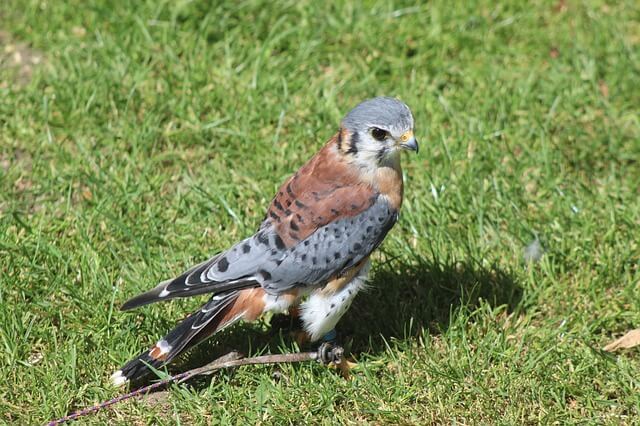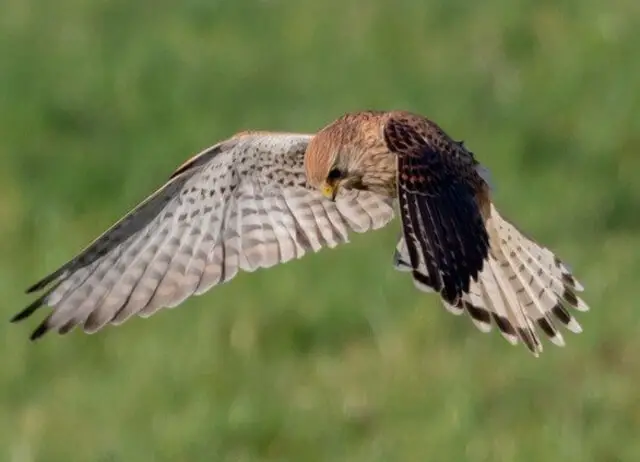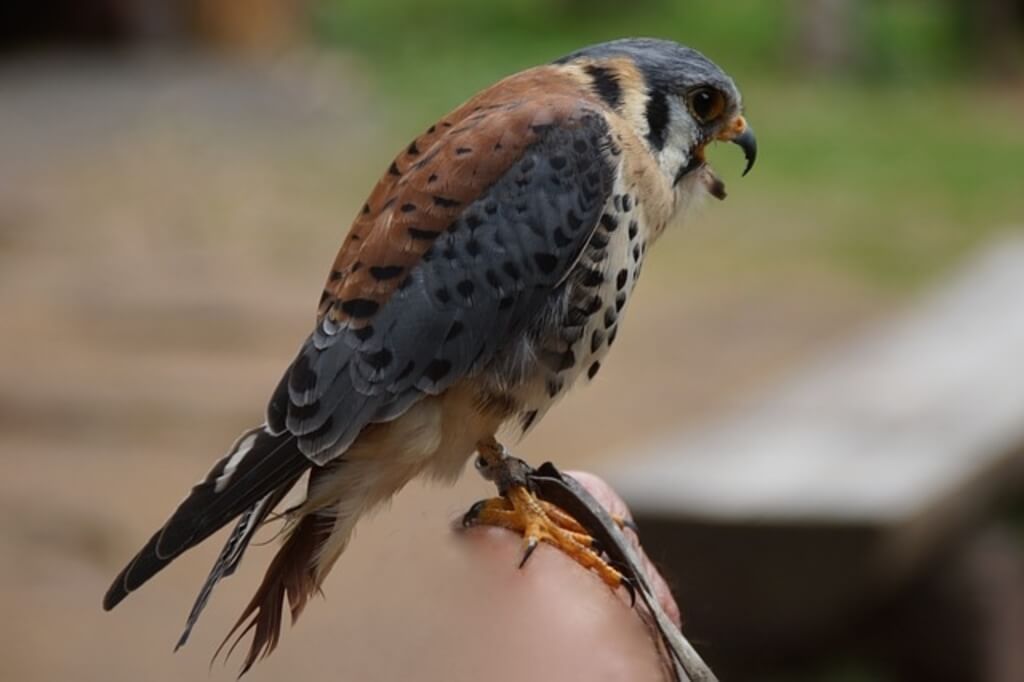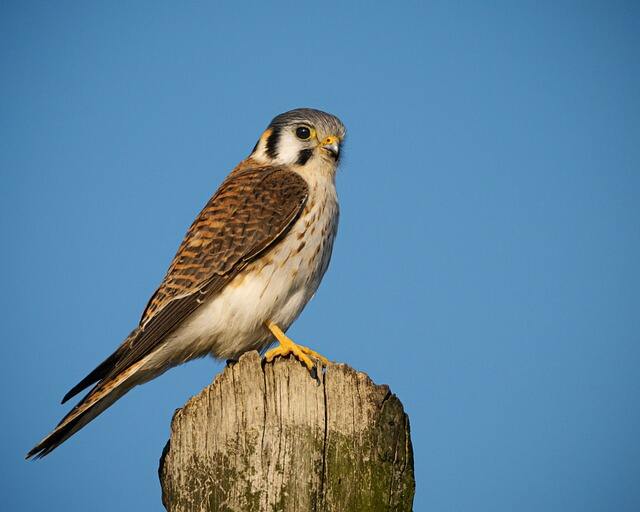The American Kestrel, scientifically known as Falco sparverius, is a small but mighty falcon native to North America. This bird of prey can be found in almost every part of the continent, except for much of Alaska, where it is absent. Known for their impressive speed and agility, American Kestrels are capable of hovering in place for short periods of time.
While they primarily inhabit open country, they can also be found in forested areas, especially near water or wetlands. In this article, we will delve into 30 American Kestrel fun facts, complete with photos, identification tips, and additional information.
Table of Contents
- 1 Key Takeaways
- 2 American Kestrel Fun Facts
- 2.1 Smallest Falcon:
- 2.2 Vibrant Plumage:
- 2.3 Wide Range:
- 2.4 Urban Adaptation:
- 2.5 Hunting Skills:
- 2.6 Hovering Hunters:
- 2.7 High-Pitched Calls:
- 2.8 Territorial Birds:
- 2.9 Nesting Preferences:
- 2.10 Fast Fliers:
- 2.11 Long Lifespan:
- 2.12 Falconry Favorites:
- 2.13 Migratory Habits:
- 2.14 Courtship Displays:
- 2.15 Multiple Broods:
- 2.16 Gender Size Difference:
- 2.17 Eye Stripes:
- 2.18 Insect Control:
- 2.19 Migratory Raptors:
- 2.20 Conservation Concerns:
- 2.21 Ancient Avian Lineage:
- 2.22 High-Altitude Nests:
- 2.23 Limited Vocalizations:
- 2.24 Endangered Status:
- 2.25 Broad Geographic Range:
- 2.26 Fast Stooping:
- 2.27 Daytime Hunters:
- 2.28 Egg Size:
- 2.29 Distinctive Crest:
- 2.30 Conservation Efforts:
- 3 FAQ’s About American Kestrels
- 4 Author
Key Takeaways
- The American Kestrel is a small but impressive falcon native to North America.
- American Kestrels are fast and agile fliers that can hover in place for short periods of time.
- They primarily inhabit open country, but can also be found in forested areas near water or wetlands.
- American Kestrels have a diverse diet, feeding on insects, small mammals, and birds.
- Conservation efforts are essential to protect American Kestrels due to habitat loss and pesticide use.

| Characteristic | Description |
|---|---|
| Coloration | Vibrant blue-gray wings, rufous back |
| Length | Approximately the size of a robin |
| Weight | Varied, with adults up to 5.8 oz (165 g) |
| Wingspan | About 20 inches (51 cm) |
| Range | North America, Central America, South America, Caribbean Islands |
| Habitat | Diverse habitats including open fields, grasslands, urban areas, and woodlands |
American Kestrel Fun Facts
Smallest Falcon:
As the smallest falcon in North America, the American Kestrel, measuring roughly the size of a robin, embodies a fascinating paradox of power in a petite package. Despite its diminutive stature, this bird of prey boasts boundless energy and keen hunting skills. Its compact frame houses a tenacious spirit, making it a dynamic and charismatic presence in the avian world.
Vibrant Plumage:
Male American Kestrels flaunt striking blue-gray wings and a rufous back, while females adopt a more subdued attire. These distinct colorations serve both functional and aesthetic purposes, helping males attract mates and marking these raptors as visually captivating figures in the natural landscape.
Wide Range:
From the Arctic Circle to the southernmost realms of Tierra del Fuego, American Kestrels have established themselves as adaptable wanderers, earning the distinction of one of the most broadly distributed falcons across the Americas. Their ability to thrive across diverse landscapes reflects their resilience and survival prowess.
Urban Adaptation:
American Kestrels have gracefully transitioned into urban environments, embracing cityscapes as nesting grounds. They readily embrace man-made structures, such as skyscrapers and bridges, as perches for hunting and surveying their territory. This remarkable adaptability underscores their coexistence with human habitats, providing bird enthusiasts with ample opportunities to witness their beauty.
Hunting Skills:
Renowned for their exceptional hunting skills, American Kestrels possess a discerning palate, primarily consisting of insects, small mammals, and birds. Their hunting technique is a masterpiece of precision and speed, combining sharp eyesight, rapid flight, and the unique ability to hover in mid-air during the hunt. These attributes collectively elevate them to the ranks of agile aerial predators in the avian realm.
Hovering Hunters:
American Kestrels are renowned for their remarkable hovering ability. When hunting, they can suspend themselves in mid-air, akin to a miniature helicopter, while scanning the terrain below with remarkable precision. This unique skill allows them to spot potential prey, such as insects or small mammals, and execute rapid strikes. The kestrel’s hovering behavior showcases its exceptional agility and adaptability as skilled aerial predators.
High-Pitched Calls:
American Kestrels communicate with a repertoire of high-pitched calls, often described as “killy-killy-killy.” These vocalizations serve multiple functions, from defending territory to courtship rituals. Their sharp, piercing calls resonate through open fields and woodland edges, providing both a soundtrack to their habitat and a means of asserting their presence to rivals and potential mates alike.

Territorial Birds:
American Kestrels are fiercely territorial, with each pair of kestrels actively defending their chosen hunting grounds. Their territories are not just spaces for hunting; they’re crucial for securing adequate food supplies and safe nesting sites. Kestrels’ territorial nature ensures an abundant food supply and a secure environment for raising their young.
Nesting Preferences:
When it comes to nesting, American Kestrels display remarkable adaptability. They may take up residence in tree cavities, abandoned nests of other birds, or readily accept man-made nest boxes. This adaptability ensures their survival in various habitats and reflects their resilience in the face of habitat changes.
Fast Fliers:
Renowned for their agility in flight, American Kestrels are incredibly swift and agile. Their rapid, darting movements allow them to chase down prey with pinpoint accuracy. When in pursuit of a meal, they can execute astonishing aerial maneuvers that rival those of larger raptors. This speed and agility make them formidable hunters in the avian world, despite their small size.
Long Lifespan:
In the wild, American Kestrels can live for about 5 to 10 years, showcasing their resilience and adaptability. Remarkably, some individuals in captivity have exceeded these expectations, with lifespans reaching up to 17 years. This longevity allows them to contribute significantly to their ecosystems and inspires admiration among bird enthusiasts.
Falconry Favorites:
American Kestrels are among the preferred birds for falconry enthusiasts. Their manageable size, hunting skills, and trainable nature make them excellent candidates for this ancient practice. Falconers have developed a deep appreciation for these birds’ abilities, further enhancing their reputation.
Migratory Habits:
While many American Kestrels are year-round residents in their territories, some populations undertake migratory journeys to respond to changing weather patterns and food availability. These migrations can span thousands of miles, demonstrating their adaptability in the face of seasonal challenges.
Courtship Displays:
During the breeding season, male American Kestrels engage in captivating aerial displays to court potential mates. These displays often include hovering flights and the presentation of food gifts to females. Such courtship rituals showcase their agility and serve as visual spectacles in the sky, reaffirming their status as charismatic raptors.
Multiple Broods:
American Kestrels are known for their prolific breeding, often producing more than one brood of chicks in a single breeding season. Their ability to rear multiple generations of offspring underscores their reproductive success and population resilience, contributing to their continued presence in diverse ecosystems.
Gender Size Difference:
In American Kestrels, females are typically larger than males, boasting longer wings and tails. This size dimorphism is a notable feature in raptors and reflects differences in hunting strategies and roles within the pair.

Eye Stripes:
Both male and female American Kestrels possess striking black markings around their eyes, resembling sideburns. These distinctive eye stripes not only add to their aesthetic appeal but also serve functional purposes, reducing glare and enhancing their visual acuity while hunting.
Insect Control:
American Kestrels play a crucial role in agricultural ecosystems by helping control insect populations. Their diet includes grasshoppers, beetles, dragonflies, and other pests, making them valuable allies for farmers and contributing to pest management.
Migratory Raptors:
Some American Kestrels are migratory, undertaking seasonal journeys in response to changing weather conditions and food availability. These migrations can cover thousands of miles and require navigation skills that add to their mystique.
Conservation Concerns:
Despite their adaptability, American Kestrel populations have faced declines in some areas, possibly due to habitat loss, pesticide use, and competition with other cavity-nesting species. Conservation efforts are underway to protect their habitats, provide nest boxes, and monitor populations to ensure their continued presence in the natural world.
Ancient Avian Lineage:
American Kestrels belong to an ancient avian lineage that has evolved over millions of years. Their survival and adaptability over such a long timespan highlight their resilience and evolutionary success as a species.
High-Altitude Nests:
While they nest in a variety of locations, including tree cavities and nest boxes, some American Kestrels prefer high-altitude nesting sites on cliffs or rocky ledges. These lofty nests provide safety and a clear vantage point for hunting.
Limited Vocalizations:
Kestrels are not known for their extensive vocalizations. They primarily communicate through their distinctive “killy-killy-killy” calls, making their vocal repertoire relatively simple compared to other bird species.
Endangered Status:
American Kestrels are currently classified as a species of “Least Concern” by the International Union for Conservation of Nature (IUCN). While some populations may be facing challenges, they are not considered threatened or endangered at a global level.
Broad Geographic Range:
American Kestrels have carved out a niche in diverse geographic regions, from the tundra of the Arctic to the lush forests of South America. Their ability to adapt and thrive across such a broad range is a testament to their versatility and adaptability as a species.
Fast Stooping:
When hunting, American Kestrels can execute rapid stoops, or dives, at remarkable speeds of up to 60 miles per hour (97 kilometers per hour). This impressive aerial skill allows them to surprise and capture prey with astonishing precision, highlighting their adaptability as agile predators.
Daytime Hunters:
American Kestrels are primarily diurnal, meaning they are most active during daylight hours. Their daytime hunting habits make them readily observable to birdwatchers and enthusiasts, as they often perch on prominent spots, such as wires or trees, while scanning for prey.
Egg Size:
Female American Kestrels lay small, speckled eggs, typically numbering between 3 to 7 in a clutch. These eggs are carefully incubated by the female, ensuring the survival of the next generation of kestrels.
Distinctive Crest:
One of their distinctive features is a pointed crest of feathers on their head. This crest adds to their striking appearance and sets them apart from other small raptors.
Conservation Efforts:
Recognizing the importance of American Kestrels in maintaining ecosystem balance, numerous conservation initiatives have been launched. These efforts include providing nest boxes, monitoring populations, and raising awareness about their significance in local ecosystems. By safeguarding their habitats and addressing threats, conservationists aim to secure the future of these charismatic raptors.

FAQ’s About American Kestrels
How fast can an American kestrel fly?
The average speed of an American kestrel in flight is 40 mph (64 km/h). The fastest recorded speed was 55 mph (88 km/h) when diving to the ground while hunting prey.
How much does a kestrel eat per day?
The kestrel eats small mammals, birds, insects, and typically feeds on rodents such as mice and voles. One might assume that it would not need to eat much food per day, but the opposite is true because it eats an astounding amount! A kestrel will consume approximately 500 grams of meat in one day, which translates to about 25% of its body weight.
Will a kestrel take a chicken?
Kestrels are beautiful birds of prey, but they won’t attack your chickens. They do enjoy eating smaller animals like rodents and insects, so if your yard has any of these pests, it’s possible that the kestrel will come by occasionally to feed on them.
How fast can an American kestrel dive?
The American kestrel is a small falcon that can dive at speeds of up to 55 mph. An average, healthy adult kestrel has the ability to reach speeds of up to 55 miles per hour in just 3 seconds and maintain those speeds for another 2-3 seconds before it reaches its target.
Do American kestrels eat snakes?
Insects are the main food source for American kestrels, and they will also eat small mammals such as mice and voles. They have been known to hunt reptiles such as lizards, or snakes, other birds, amphibians and even bats in their natural habitat.




